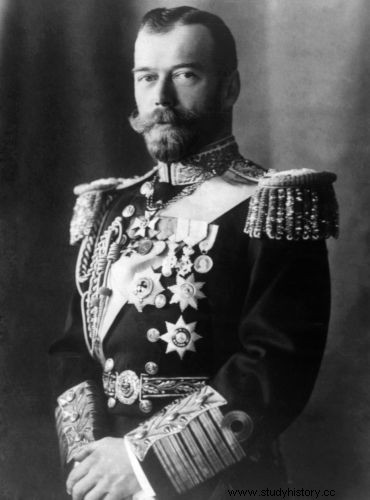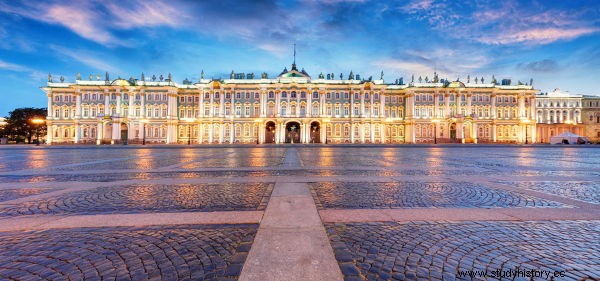
The Sunday Bloody It took place on January 9, in the Julian calendar (January 22, in the Gregorian calendar). At this event, the population of St. Petersburg held a peaceful demonstration asking for improvements in the lives of workers and greater opening up of the country. The result was a massacre of the population by the troops protecting the emperor's palace.
Login also :Rasputin, the mad monk from Russia
Bloody Sunday Summary
-
Bloody Sunday was a massacre of the Russian population, after they staged a march in Saint Petersburg in January 1905.
-
The demonstration was peaceful and called for improvements in the lives of workers and more political opening for the country.
-
The demonstration was the result of a general strike initiated by the dismissal of four blue-collar workers.
-
After Bloody Sunday, the emperor became known as Nicholas the Bloody.
-
The uprising caused by the massacre sparked protests that were part of the 1905 Revolution.
Bloody Sunday historical context
Bloody Sunday was a landmark event in Russian history, as it began a period of heightened tension among the country's population over Emperor Nicholas II . To better understand this event, it is important to take a look at the context of this country at the beginning of the 20th century.
First we must start with the fact that Russia, at the beginning of the 20th century, had a monarchy known as tsarism . This monarchy had some similarities with a model of absolutist monarchy, and its representatives were part of the Romanov dynasty , which had been in power in the country since the 17th century.
Furthermore, Tsarism maintained a power autocratic in Russia, where there was no room for opposition, as the government used its political police to persecute the regime's opponents, in addition to not guaranteeing certain freedoms, such as freedom of the press. Nothing better exemplifies the lack of political freedom in Russia than the absence of a legislature.
In addition to being an autocratic country, Russia also had big problems economics . Its industrialization was late, and some industrial centers emerged in the country at the end of the 19th century. Russian industrialization was not accompanied by investments for the country's agricultural development, and, as a result, agricultural production was inefficient.
This inefficiency worsened the plight of the poor. The bulk of the Russian population was made up of worker workers and peasants, precisely the biggest victims of the country's social inequality. Hunger, poverty and misery were very common realities in these layers of the country.
In this context of poverty, misery and authoritarianism, socialist ideas began to gain ground through the Russian Social Democratic Labor Party , the RSDLP. Inspired by the ideas of Karl Marx , this party started to approach the labor movement and the popular classes of the country. Within it, one of the working groups were the Bolsheviks , who advocated an armed revolution.
Login also :Moscow, the biggest city in Russia
What was Bloody Sunday?
As we can see, Russian society was complex, and despite the relative popularity of Emperor Nicholas II, dissatisfaction was already being felt. The starting point for Bloody Sunday to occur was at the end of 1904, when four workers were fired from a factory which was in the city of Saint Petersburg, then the capital of the country.
The dismissed workers were part of the Assembly of Russian Factory Workers, a workers' association formed by ex-Marxists. The dismissals, with unconvincing justifications, upset the working class of St. Petersburg. Dissatisfied, the workers called a gr and ve general which had great support from the city's workers.
There was an attempt to negotiate for the laid-off workers to be reinstated, but these efforts failed. The agitator behind the workers' dissatisfaction was an Orthodox priest named Gueorgui Gapon , the leader of the Assembly of Russian Factory Workers. In this context, the priest decided to lead a mobilization of workers through the streets of the city.
-
The March

The march called by Gapon took place on January 9 1905, according to the Julian calendar (in the Gregorian calendar, January 22). The march was convened to take place on the streets of Saint Petersburg and had as its final destination the Winter Palace , residence of Emperor Nicholas II.
At the end of this march, the workers' representatives would present a petition to the emperor, proposing that he initiate some reforms in Russia. Among the requests were a request for an increase in workers' salaries, a reduction in working hours, as well as a political opening in the country, with the promulgation of a Constitution and the call for free elections.
The demonstration taking place in the streets of St Petersburg was peaceful, and many carried images of saints (Russia is a mostly Orthodox country). In addition, many of those present were supporters of the Emperor and brought images of Nicholas II as a form of tribute. Patriotic hymns and religious songs were sung by those present.
The emperor's reaction was the worst possible. He did not appear to receive the workers' petition and, moreover, authorized the soldiers guarding the palace to open ses fire against the population . The attack by Russian troops on civilians turned the march into a real massacre, and violence spread through the city.
Estimates about this event are quite mixed, but it is said that at least 130 people died . Other statistics point out that more than 1000 people may have died that day. It is believed that the action of the Russian troops was deliberate and that it happened with the permission of the emperor.
Login also :Russian Civil War (198-1921) – caused by the White Army against the Bolsheviks
Consequences of Bloody Sunday
Bloody Sunday was an event that marked Russia. Society was shocked by the unnecessary violence because, as we have seen, it was a peaceful demonstration with many supporters of Nicholas II. The emperor came to be frowned upon, seen as an enemy of the people, and called by the people Nicholas the Bloody .
In addition, Bloody Sunday served as a trigger for dissatisfaction to take over the country. Protests spread across major Russian cities in a massive display of popular dissatisfaction. The people's revolt took into account the indignation for Bloody Sunday, but also for a number of other reasons, such as:
-
Dissatisfaction with poverty;
-
Dissatisfaction with the monarchy's authoritarianism;
-
Dissatisfaction with defeat in the Russo-Japanese War.
The protests that took place in the country in 1905 were called Essay General and were understood as a kind of demonstration of what was to come in 1917.
